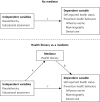The contribution of health literacy to disparities in self-rated health status and preventive health behaviors in older adults
- PMID: 19433837
- PMCID: PMC2682976
- DOI: 10.1370/afm.940
The contribution of health literacy to disparities in self-rated health status and preventive health behaviors in older adults
Abstract
Purpose: Health literacy is associated with a range of poor health-related outcomes. Evidence that health literacy contributes to disparities in health is minimal and based on brief screening instruments that have limited ability to assess health literacy. The purpose of this study was to assess whether health literacy contributes, through mediation, to racial/ethnic and education-related disparities in self-rated health status and preventive health behaviors among older adults.
Methods: We undertook a cross-sectional study of a nationally representative sample of 2,668 US adults aged 65 years and older from the 2003 National Assessment of Adult Literacy. Multiple regression analysis was used to assess for evidence of mediation.
Results: Of older adults in the United States, 29% reported fair or poor health status, and 27% to 39% reported not utilizing 3 recommended preventive health care services in the year preceding the assessment (influenza vaccination 27%, mammography 34%, dental checkup 39%). Health literacy and the 4 health outcomes (self-rated health status and utilization of the 3 preventive health care services) varied by race/ethnicity and educational attainment. Regression analyses indicated that, after controlling for potential confounders, health literacy significantly mediated both racial/ethnic and education-related disparities in self-rated health status and receipt of influenza vaccination, but only education-related disparities in receipt of mammography and dental care.
Conclusions: Health literacy contributes to disparities associated with race/ethnicity and educational attainment in self-rated health and some preventive health behaviors among older adults. Interventions addressing low health literacy may reduce these disparities.
Figures
References
-
- Kutner M, Greenberg E, Baer J. Adult Literacy in America: A First Look at the Findings of the National Adult Literacy Survey. Washington, DC: National Center for Educational Statistics; 2005. Report No. NCES 2006470.
-
- White S. Assessing the Nation’s Health Literacy: Key Concepts and Findings of the National Assessment of Adult Literacy (NAAL). Chicago, IL: American Medical Association Foundation; 2008.
-
- Proceedings of the 2005 White House Conference on Aging Mini-Conference on Health Literacy and Health Disparities. Chicago, IL: American Medical Association; 2005.
Publication types
MeSH terms
Grants and funding
LinkOut - more resources
Full Text Sources
Medical

